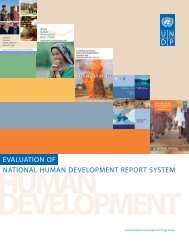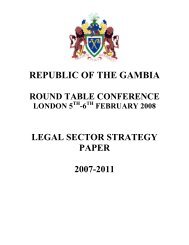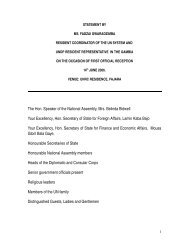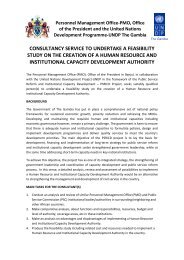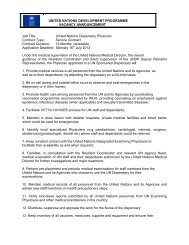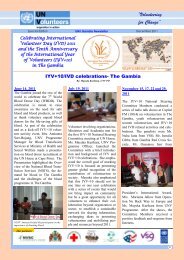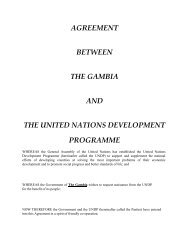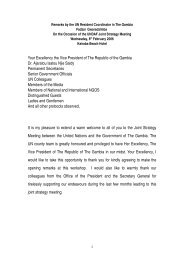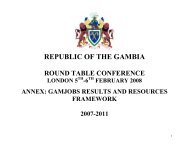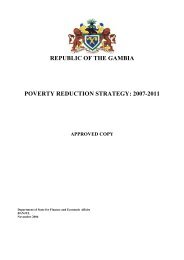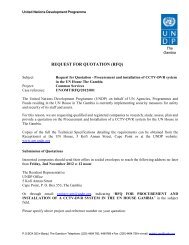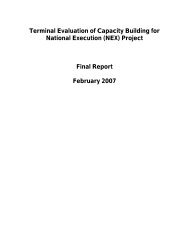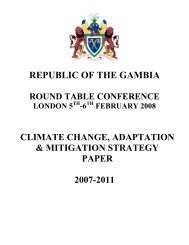Introduction - UNDP The Gambia
Introduction - UNDP The Gambia
Introduction - UNDP The Gambia
Create successful ePaper yourself
Turn your PDF publications into a flip-book with our unique Google optimized e-Paper software.
________________________________________________________________________________________________________________________<br />
<strong>Gambia</strong>n Environmental Action Plan<br />
(GEAP). <strong>The</strong> Jaatakendeya kafoo (health and<br />
well-being) links community residents with<br />
the health programme of the Department of<br />
State for Health and Social Welfare. <strong>The</strong><br />
Trust Agency for Rural Development<br />
(TARUD) is a local development agency<br />
whose activities are directed at empowering<br />
Gunjur and the neighbouring communities to<br />
embark on development on a sustainable<br />
basis.<br />
Thus the longstanding institution of the kafoo<br />
is being invoked in current contexts to<br />
mobilise people around externally motivated<br />
causes, and those that link communities to<br />
national and international processes. This<br />
confirms Carney’s point that ‘‘kafoolu are<br />
quite versatile and engage in a range of<br />
activities that belie their singular<br />
classification in rural development as<br />
traditional reciprocal labour networks into<br />
work groups for hire during peak farming<br />
operations like weeding and transplanting’’<br />
(Carney, 1992:76). International NGOs are<br />
able to work effectively at the community<br />
level through the links they have with these<br />
structures.<br />
While the kafoo is constituted by reciprocal<br />
relationships centred on labour relations and<br />
support, the kuroo (plural kuroolu) is a further<br />
decision-making structure based largely on<br />
age-grade dynamics, where different groups<br />
succeed each other in the community through<br />
seniority.<br />
A fundamental feature of the kuroo is that<br />
membership is based on age. At the same<br />
time, founding family members are given key<br />
positions of leadership, power and control. It<br />
is the kuroolu that succeed each other as<br />
members of the Council of Elders in many<br />
<strong>Gambia</strong>n communities and they take part in<br />
important development decisions that affect<br />
the village. <strong>The</strong> existing kuroo, which<br />
presides over the community’s current issues,<br />
always works closely with the next kuroo that<br />
is to succeed it.<br />
Total succession is based on the death of most<br />
of the current members, which takes a very<br />
long time. Thus negotiations over leadership<br />
and succession are common features of kuroo<br />
dynamics. This has led to sustainable<br />
leadership in many communities.<br />
Recent trends indicate that both kuroo and<br />
kafoo dynamics are changing in the context of<br />
the numerous social, political and economic<br />
changes, which seem to be weakening the<br />
importance of the supportive social dynamics<br />
provided by these institutions. <strong>The</strong>se include<br />
education and the mobility it offers to people<br />
in the community. Migration and economic<br />
change have also brought other forms of<br />
social network based on the multiple<br />
economic activities that people are now<br />
engaged in.<br />
<strong>The</strong> kuroo and kafoo seem to be responding<br />
flexibly to new circumstances and dynamics,<br />
sometimes giving way to new professional<br />
and political groupings, but also being reactivated<br />
in new roles, such as in linking<br />
village residents with external development<br />
activities. For example, there are several<br />
initiatives under DOSE that link communities<br />
with European institutions to support each<br />
other on relevant issues, such as education,<br />
health and networking for development.<br />
Village Development Committee (VDC): <strong>The</strong><br />
village development committee consists of<br />
the alkalo, saate kafoo, the women’s leader,<br />
youth<br />
representative and all the government<br />
development agencies within the community.<br />
It is the superstructure and the conduit<br />
through which all the traditional systems<br />
within the communities organise development<br />
initiatives. <strong>The</strong> VDC represents the entire<br />
traditional political structure and leadership.<br />
It is also the intermediary between the<br />
government and the people.<br />
Within this structure, government<br />
development policies are introduced through<br />
various departments that work with the<br />
community. Most development work is<br />
implemented through the village development<br />
committee. If well managed, the VDCs can<br />
be an effective body to achieve the targets of<br />
________________________________________________________________________________________________<br />
Building Capacity for the Attainment of the Millennium Development Goals in <strong>The</strong> <strong>Gambia</strong> National Human Development Report 2005<br />
56




